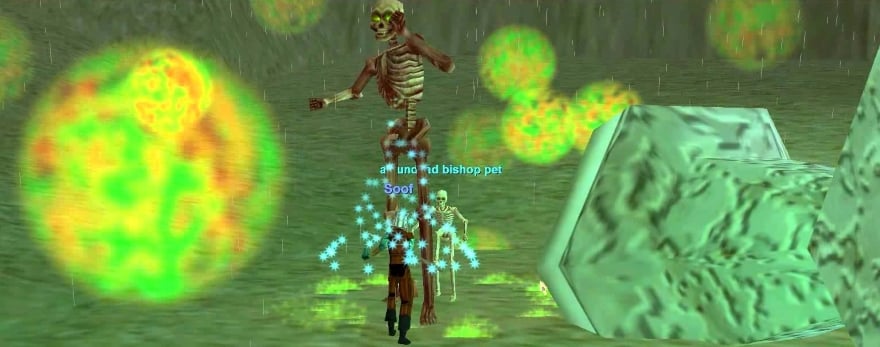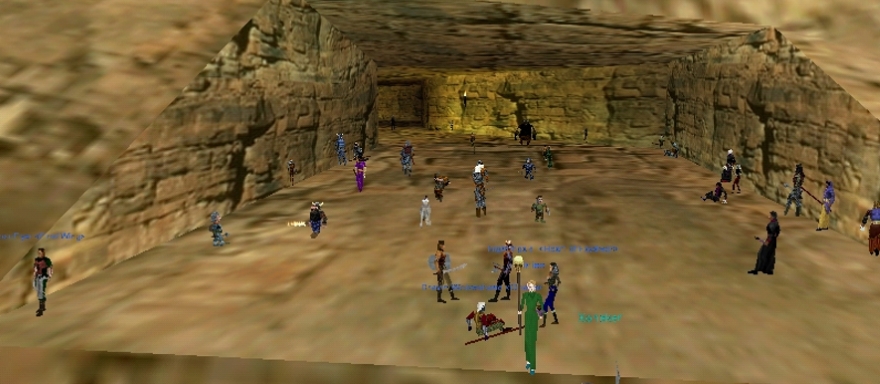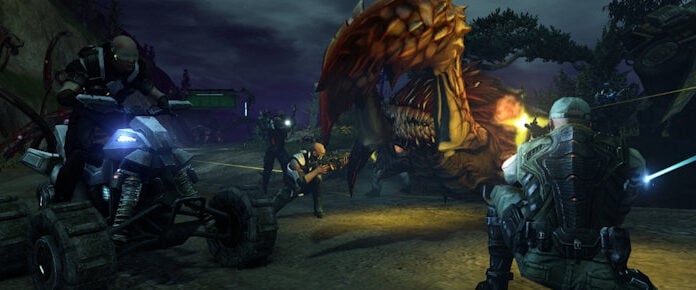
MMOs change. We know that, but we also tend to forget it as well. The games that we play today can often be light-years distant from how they used to be when they launched, especially if they’ve been around for well over a decade.
I was never part of the EverQuest scene back in the day (or even now), but I’ve always been fascinated with random tales and tidbits of how the game used to be versus how it is now. With that in mind, I put out a call to player vets who were there back in ’99 to share some of the facts of EQ life. The deluge of stories that I got in return was staggering, and I’m excited to share them with you.
How was the game different? What mechanics and obstacles did players have to deal with that are unheard of today? Check out what those who were on the scene in 1999 had to say!
 1. Atrocious user interface
1. Atrocious user interface
“EQ’s initial UI was designed around a first-person camera. The UI formed a pretty big ‘box’ around the edges of the screen, and in the middle of the box was where you could actually see what your character was doing. Later the UI got redone so that there was more viewable space.” (David B.)
“Wow, the UI was bad. A tiny window on the world surrounded by huge panels. It was far from intuitive — and very clunky. When a Mage had to meditate, that tiny window was taken up with a spell book so you couldn’t see anything of the world around you. The first time I played, it took me an hour to figure out how to make a ‘run’ hotkey. Back then, though, we didn’t care. For the first time I was able to take my Dungeons & Dragons game into the computer and play it with my friends. It was like magic.” (Neil)
2. Want a map? Draw it yourself!
“There was a complete lack of an in-game map. Finding your way around the world involved a compass-like skill called Sense Heading that players had to train up to see which direction they were currently facing.” (B.J.)
“During the majority of my time playing EverQuest, the only maps that existed were hand-drawn. We kept them printed in a folio beside the computer for when we needed to run through zones that we were less familiar with. Many players considered the maps to be ‘cheating,’ so while most people used them, they never really talked about using them in open chat.” (Mark T.)
3. Reputation was everything
“Server populations in 1999 were such that you knew the other members of your given class, especially if it was an uncommon one, such as the Bard. When there were only a dozen or two (at the most) of your given class online at a time, you weren’t faceless. Your reputation on the server was everything.” (Michael R.)
“With EQ being such a social game and group activities being more or less mandatory, reputation was very important. If you made a name for yourself as a bad person, the entire server would soon learn who you were and refuse to group with you. Likewise, if people liked you, quite often you would find yourself welcomed to any group or raid you wanted to join.” (David B.)
 4. Travel took forever
4. Travel took forever
“One of the first things I always remember about EQ at launch was how vast it was. Travelling across zones on foot could take 30 minutes to an hour for just one zone; there was no fast travel. I remember getting a PUG together and deciding that Blackburrow was too crowded with players. So we made the hour or so run out the Splitpaw in West Karana and had the whole dungeon to ourselves. Another nod to the vastness was the boat trip, especially when you had to wait 45 minutes for the boat to come back around if you missed it.” (Bill C.)
“Druids and Wizards would often advertise ‘taxi’ services for donations to make extra money, which they needed to buy their spells.” (David B.)
5. Downtime forged friendships
“Whether it was killing time between spawns, waiting for mana/health to regen for the next fight, waiting for or riding the boat, or waiting for your Monk to successfully feign death to pull a boss from halfway across the zone, EQ had a lot more downtime than modern games. Players would fill this time in various ways, like playing Bejeweled, watching TV, or two-boxing the game — but most of all, people chatted with and got to know each other.” (Gamhuin)
“In most groups, you had downtime between fights where the group had to rest to regen mana. Crossing oceans required you to wait for a boat that took 15 minutes to show up and another 15 minutes to cross the ocean zone to your destination. While a lot of people might look at these things and say, ‘Ugh, how is that fun?’ the actual effect was that players spent that time talking to each other, making friends, and forming guilds. If EQ had worked like today’s games where the action was happening all the time, a lot of those bonds between players simply never would have formed.” (David B.)
6. Many played on dial-up
“Another difference that comes to mind was the technology of the internet. I myself and many others were on dial-up internet while playing EQ in those days. I was in a raid that finished around 4:00 a.m. and I had just won the roll for the Cloak of Flames off of Nagafen. Then I got disconnected — my friend’s sister picked up the telephone to make a phone call! Luckily, we yelled downstairs for her to get off the phone and I was able to reconnect in time to get my CoF.” (Hieru)
 7. Bards rocked, period.
7. Bards rocked, period.
“I loved song turning with a Bard. Basically, you had different items for different abilities and buffs. From this you had to play first ability with first item, then switch the item out manually to the second, then play the second ability. Rinse and repeat for the four abilites/items. It was a busy and rewarding playstyle.” (Bill C.)
“Players from back in 1999 will understand what twisting is. A quirk in the game mechanics meant that Bards could keep three (or more) different Bard songs playing at once, tripling their effectiveness. There were no macros back then. It required cycling the songs by timing keystrokes. It wasn’t always easy to get into the right rhythm, especially in the heat of combat, and good Bard players were valued for the skill and dexterity of their players, not just their gear.” (Neil)
8. Hell levels
“I remember the overwhelming experience costs while leveling. And hell levels. Do you remember hell levels? Those were the worst.” (Mike J.)
 9. East Commonlands Tunnel was the place to be
9. East Commonlands Tunnel was the place to be
“It’s been written about in EverQuest retrospectives for years, but the reason that the East Commonlands Tunnel keeps getting brought up is because the social impact it had on players back then can’t be understated. It was a place to meet, to trade, to roleplay, to hold guild meetings, or just to go and /inspect other players equipment. It was a natural meeting place and auction house environment that was created solely by the players, without direction from the developers. The amazing thing is that this seemed to occur naturally on all servers, independently of one another.” (Neil)
“There was no auction house, but instead an organic community arose in the East Commonlands Tunnel or North Freeport to sell items.” (Bob S.)
“I kind of miss that community aspect of East Commonlands or North Freeport. There was no auction house, and the Bazaar hadn’t been released yet, so that was a huge aspect of the game that you’re likely to never see again.” (Mike J.)
10. You think you know dark? You know nothing JonSnow89.
“I remember that at night it was so dark, as a human you could barely see and would be running into walls and off cliffs. Making a Dark Elf was great then as the vision power they got make seeing at night easy.” (Bill C.)
“Some races could see in the dark and others couldn’t. When it was nighttime, my human was staring into pitch blackness, essentially useless — while my Dark Elf was just fine, gallivanting around and doing as he pleased.” (B.J.)
Just wait: There’s more!
As I said, I received many responses and stories to my call. Thus, we’ll be revisiting this topic in a couple of weeks with even more tales. In the meantime, share your favorite old-school EverQuest memories in the comments!
 Believe it or not, MMOs did exist prior to World of Warcraft! Every two weeks, The Game Archaeologist looks back at classic online games and their history to learn a thing or two about where the industry came from… and where it might be heading.
Believe it or not, MMOs did exist prior to World of Warcraft! Every two weeks, The Game Archaeologist looks back at classic online games and their history to learn a thing or two about where the industry came from… and where it might be heading.














